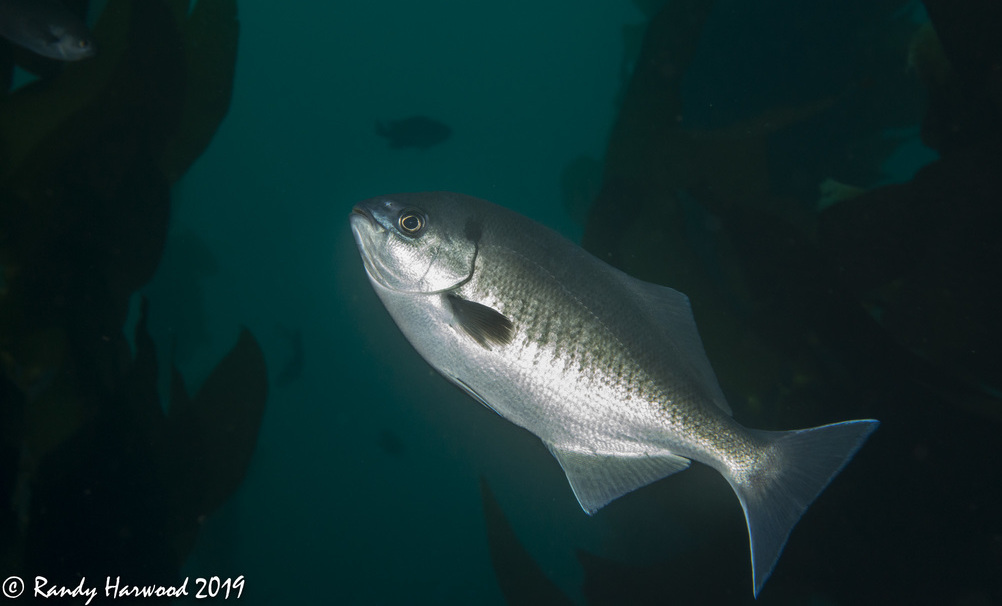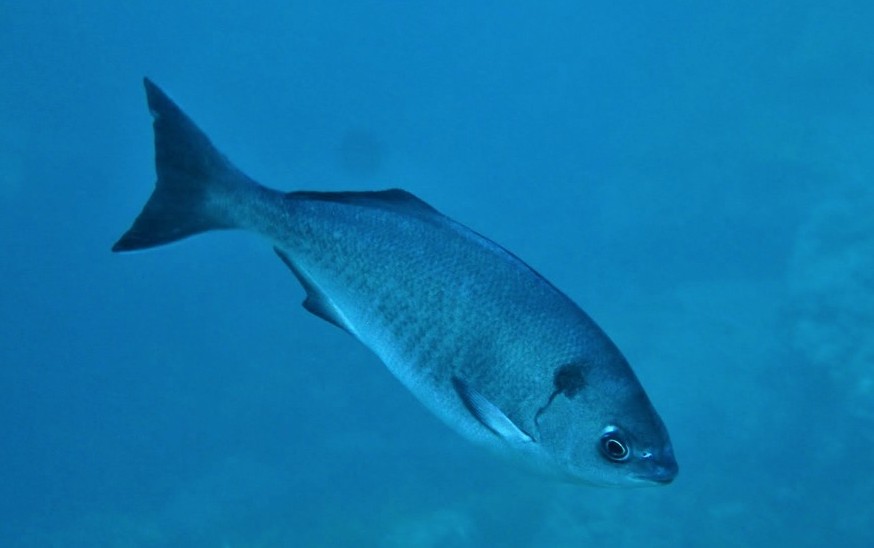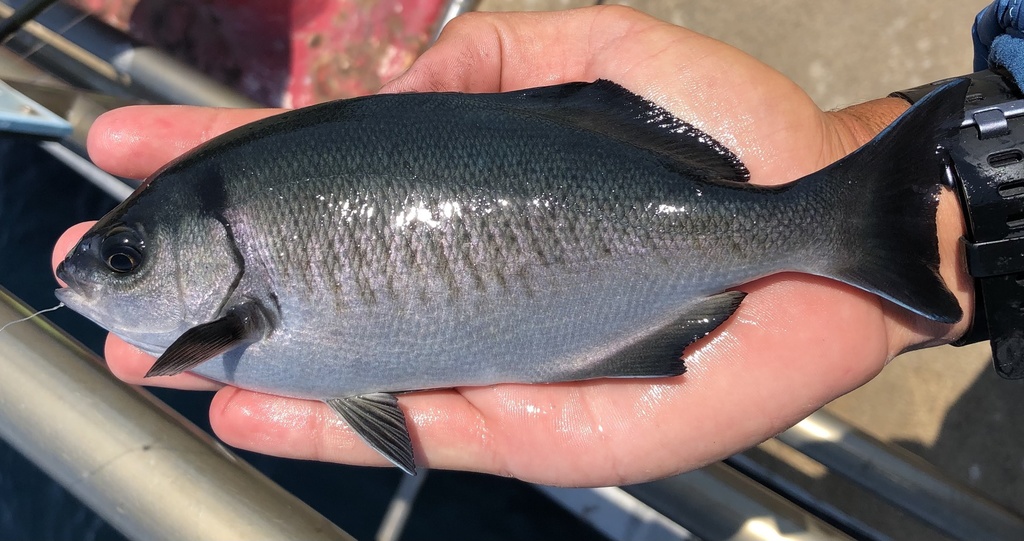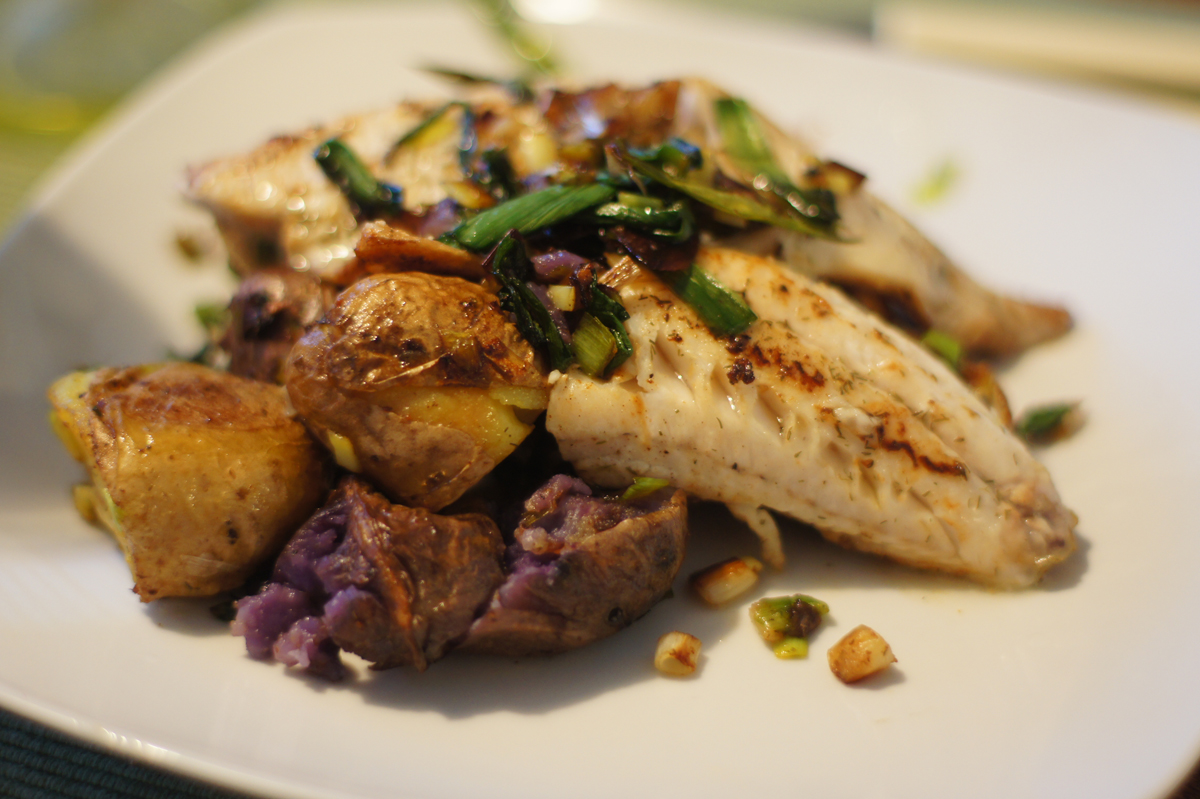Medialuna californiensis
North Coast (Oregon Border to Point Arena)
North Central Coast (South of Point Arena to Half Moon Bay)
Central Coast (South of Half Moon Bay to Point Conception)
Santa Barbara (Point Conception to Point Dume)
South Coast (Point Dume to Mexico border)
Flakey fish
Wild caught

The Science

Taxonomic description
- Tail fin shape looks like a crescent moon, hence its name. [13]
- Oval body and typically dark blue in color [9], dark spot just above gill opening [14], looks similar to opaleye. [1]
- Matures at around 20-34 cm (8-13 in.), but can reach up to 50 cm (~20 in.). [2]
- Scales are small, thick and rough. [14]
Distribution
- Ranges from Gulf of California to Vancouver Island, British Columbia. [9]
Life history
- Typically lives from 1-8 years. [14]
- Sexually mature at about 2 years old, internal fertilization, spawns eggs during July to October. [14]
- Fertilized eggs and hatched larvae float in the water column as plankton. [14]
- Juveniles typically school together and are sometimes found mixed with pile perch schools of 15-50 members. [14, 6]
Habitat
- Typically inhabits shallow rocky areas, kelp beds and floating kelp paddies. [9]
- Common predators include sea lions, larger fish, and, specifically at the Santa Catalina Island, bald eagles. [14]
- Susceptible to disturbances that influence its kelp forest home, like habitat degradation and pollution. [4]
The Fishery

Seasonal availability
- Available from August to April. [19]
Regulatory and managing authority
- As it is sometimes caught as bycatch by fisheries targeting other species, this species is not included in any specific fishery management plan, but still falls under the jurisdiction of CDFW and CFGC as per the Marine Life Management Act. [8]
Gear type
- Mostly hook and line, with some incidental catch in traps and round haul nets. [8]
- For bait and tackle, this fish prefers mussels or small crabs. [7]
Status of the fishery
- There are no regulations specific to this species; before 1976, catch of this species was grouped into the category of ‘surf perch,’ a more popular species, but now catch is reported separately. [8]
- Despite dips and peaks since 1970, there was overall decline in amount of halfmoon perch caught per year, with 0 pounds reported 1996-2002 [12] due to poor documentation, and perch species were often unspecified. [8]
- The IUCN Red List classifies halfmoon perch as “least concern” throughout its range. [5]
- The recreational fishery is larger than the commercial fishery for this species. [20]
Potential ecosystem impacts
- According to a Productivity Susceptibility Analysis, this species has a low risk of being impacted by fishing activities. [10]
- No significant ecosystem impacts known.
The Seafood

 Edible portions
Edible portions
- Can be eaten whole, scaled, and/or gutted. [18]
 Description of meat
Description of meat
- Has light, white, mild flavored meat, similar to surfperch. [12, 7]
Culinary uses
- Available fresh and whole. [18]
- Often baked, grilled, breaded and fried, or sautéed. [16]
- For preparation instructions, visit Livestrong. [3]
- For recipe ideas, visit Food.com. [18]
Nutritional information
- One perch fillet is measured in the nutritional facts label. [17]
- It is rich in healthy levels of omega-3 fats and Vitamin B12. [17]
Toxicity report
- No toxins or dietary warnings. [6]
Seasonal availability
- Seasonal from August to April. [19]
References
[1] Boerger, Christiana M. 2011. “Life History, Diet, and Production of an Herbivorous Temperate Marine Fish, Medialuna Californiensis (Fam. Kyphosidae).” California State University, Northridge. http://scholarworks.csun.edu/bitstream/handle/10211.2/824/Thesis.pdf?seq....
[2] Bredvik, Jessica J., Christiana Boerger, and Larry G. Allen. "Age and growth of two herbivorous, kelp forest fishes, the opaleye (Girella nigricans) and halfmoon (Medialuna californiensis)." Bulletin, Southern California Academy of Sciences 110, no. 1 (2011): 25-34. https://doi.org/10.3160/0038-3872-110.1.25
[3] Croswell, Jonathan. 2015. “How to Cook Ocean Perch Fillets.” Web. http://www.livestrong.com/article/445749-how-to-cook-ocean-perch-fillets/.
[4] Impacts on Kelp Forests. n.d. National Marine Sanctuaries. Web. https://sanctuaries.noaa.gov/visit/ecosystems/kelpimpacts.html. Accessed 31 August 2020.
[5] International Union for Conservation of Nature and Natural Resources. 2000. The IUCN Red List of Threatened Species. IUCN Global Species Programme Red List Unit. http://www.iucnredlist.org/details/183618/0.
[6] Jones, Ken. 2014. “Pier Fish of Catalina Island.” Web. http://kenjonesfishing.com/2014/02/pier-fish-of-catalina-island/.
[7] Jones, Ken. 2017. “Halfmoon [Pier Fishing in California].” Web. https://www.pierfishing.com/halfmoon/. Accessed May 28 2017.
[8] Larinto, Traci (Editor). 2013. “STATUS OF THE FISHERIES REPORT AN UPDATE THROUGH 2011.” https://nrm.dfg.ca.gov/FileHandler.ashx?DocumentID=65489&inline.
[9] Marine Region, California Department of Fish and Game, and Nancy Wright. 2002. “Nearshore Fishery Management Plan (NFMP).” Web. https://www.wildlife.ca.gov/Conservation/Marine/NFMP#27981664-list-of-ta
[10] Micheli, Fiorenza, Giulio De Leo, Cheryl Butner, Rebecca G. Martone, and Geoff Shester. "A risk-based framework for assessing the cumulative impact of multiple fisheries." Biological Conservation 176 (2014): 224-235. https://doi.org/10.1016/j.biocon.2014.05.031
[11] Simons, R.A. 2016. ERDDAP. https://coastwatch.pfeg.noaa.gov/erddap . Monterey, CA: NOAA/NMFS/SWFSC/ERD.
[12] Spira, Jeff. Saltwater Angler's Guide to Southern California. Wilderness Adventures Press, 2007.
[13] “California Marine Sportfish Identification: Other Fishes.” 2013. October 17. https://www.wildlife.ca.gov/Fishing/Ocean/Fish-ID/Sportfish/Other-Fishes#halfmoon.
[14] “Aquarium of the Pacific | Online Learning Center | Halfmoon.” 2017. http://www.aquariumofpacific.org/onlinelearningcenter/species/halfmoon
[15] Shaw, H. The Spruce Eats. 2020. What is Pacific Surfperch? Web. https://www.thespruceeats.com/cooking-with-pacific-surfperch-1300660. Accessed 31 August 2020.
[16] “How Do You Cook Surf Perch?” 2017. Web. http://www.ifish.net/board/showthread.php?t=226190.
[17] “Fish, Raw, Mixed Species, Perch: Nutritional Value and Analysis.” Data from USDA. 2017. Web. https://www.nutritionvalue.org/Fish%2C_raw%2C_mixed_species%2C_perch_nutritional_value.html.
[18] “Perch Recipes - Food.com.” 2017. Web. http://www.food.com/topic/perch.
[19] California Department of Fish and Wildlife. 2020. 2020 California Commercial Fishing Digest. Web. https://nrm.dfg.ca.gov/FileHandler.ashx?DocumentID=175639&inline. Accessed 31 August 2020.
[20] California Marine Species Portal. 2020. Halfmoon. Web. https://marinespecies.wildlife.ca.gov/halfmoon/false/. Accessed 30 November 2020.
[21] craigjhowe. iNaturalist. 2010. Digital image. Web. https://www.inaturalist.org/photos/59026754. Accessed 16 February 2021.
[22] fieldbio. iNaturalist. 2020. Digital image. Web. https://www.inaturalist.org/photos/81173887. Accessed 16 February 2021.
[23] Guerson, A. flickr. 2011. Rainbow potatoes with Ontario Perch and green garlic. Digital image. Web. https://flickr.com/photos/guerson/5697528614. Accessed 17 February 2021.
